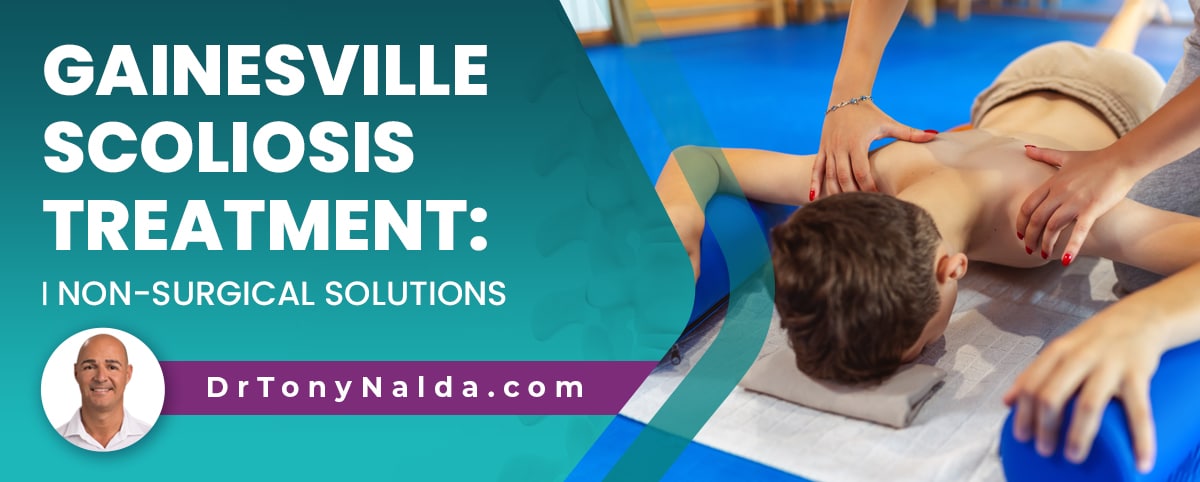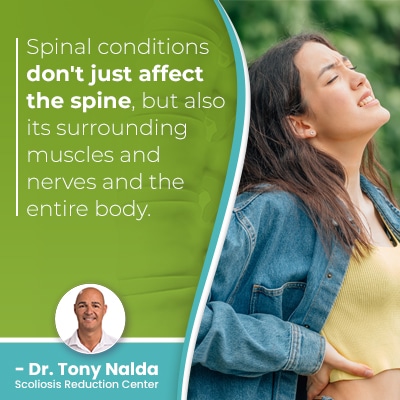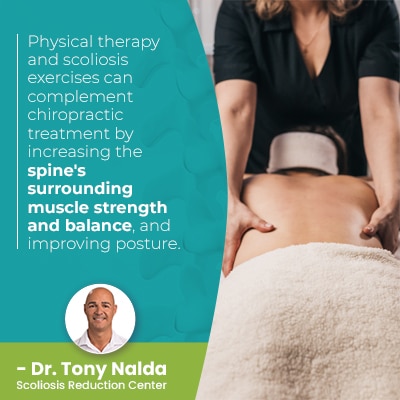Gainesville Scoliosis Treatment: Non-Surgical Solutions

Scoliosis can be treated with or without surgery, and while spinal surgery can straighten a scoliotic spine, it can also affect spinal health negatively. Scoliosis surgery can make the spine weaker and more vulnerable to injury, while conservative non-surgical treatment can preserve the spine's natural strength and function.
How a diagnosis of scoliosis is responded to is key, and a proactive and effective treatment approach can be worth traveling for. A 7.5-hour flight from Gainesville, Georgia can put residents within reach of Dr. Tony Nalda's Scoliosis Reduction Center®.
As scoliosis is progressive, treatment is about how to manage an ongoing condition effectively for the best quality of life.
Table of Contents
What is Scoliosis?
Scoliosis is a structural spinal condition that causes the development of an unnatural sideways-bending and rotating spinal curvature.
As a progressive condition, the nature of scoliosis is to get worse over time, and this means the size of the spinal curve will increase, along with the condition's uneven forces, and their effects.
Gainesville, Georgia residents can access non-surgical scoliosis treatment from one of the nation's leading providers: the Scoliosis Reduction Center® in Orlando, Florida.
Scoliosis ranges widely in severity from mild scoliosis to moderate, severe and very severe scoliosis.
Scoliosis treatment will shape the spine's long-term health and function, and while spinal surgeons have their patients' best interests at heart, scoliosis surgery can disrupt the spine's natural flexibility and strength.
 Spinal conditions don't just affect the spine, but also its surrounding muscles and nerves and the entire body.
Spinal conditions don't just affect the spine, but also its surrounding muscles and nerves and the entire body.
The best way to minimize the effects of scoliosis is to treat it proactively.
Effects of Childhood Scoliosis
Scoliosis affects all ages, but is most often diagnosed in children; the condition's most-prevalent type is adolescent idiopathic scoliosis diagnosed between the ages of 10 and 18.
The main effects of childhood scoliosis involve postural changes as the body's uneven forces disrupt the body's overall symmetry.
In most cases, the earliest signs of scoliosis in children include uneven shoulders and hips, and as scoliosis progresses, additional changes to watch for can include:
- An uneven eye line
- The head appearing uncentered over the torso
- Uneven shoulder blades
- The development of a rib cage arch
- Arms and legs that appear to hang at different lengths
The condition's uneven forces can also disrupt balance, coordination, and gait.
Effects of Adult Scoliosis
Adult scoliosis is diagnosed once skeletal maturity has been reached, and this is when scoliosis becomes a compressive condition, and compression is the main cause of condition-related pain.
Scoliosis pain can involve muscle pain, back pain, and/or pain that radiates into the extremities due to nerve compression.
Scoliosis doesn't just expose the spine to uneven forces, but also its surroundings, and the entire body.
So the main effect of adult scoliosis is pain, and the two main condition types are adult degenerative scoliosis and idiopathic scoliosis in adults.
The prevalence of idiopathic scoliosis in adults highlights the importance of early detection because these cases involve adolescent idiopathic scoliosis that was neither diagnosed nor treated during adolescence.
Degenerative scoliosis is also known as de novo scoliosis, meaning the condition has developed fresh in adulthood with no prior history, unlike idiopathic scoliosis in adults.
It's not an uncommon scenario that scoliosis isn't diagnosed until adulthood, after it has progressed significantly with time and maturity and become compressive, painful, and noticeable.
Scoliosis pain is the main scoliosis symptom that brings adults in to see me for a diagnosis and treatment and can involve back pain, muscle pain, and radiating pain into the extremities due to nerve compression.
When it comes to scoliosis care in adults, the focus is on pain management, reducing the curve size back to where it was prior to becoming painful, and increasing spinal support and stability.
Scoliosis is Progressive
As a progressive condition, the nature of scoliosis is to get worse over time, and this means its effects are becoming more overt and difficult to treat.
Scoliosis ranges from mild to moderate, severe and very severe scoliosis, and as scoliosis progresses, the spine is getting increasingly rigid and less responsive to treatment.
Increasing spinal rigidity can also make it difficult for some patients to perform key therapeutic exercises as part of treatment.
As scoliosis only gets more severe with time, making it more difficult to treat, there are a number of benefits to being proactive with treatment.
Traditional surgical scoliosis treatment options are more reactive than proactive as they commonly involve watching and waiting while conditions are mild, which is when they are the most treatable, so to me, this is wasting valuable treatment time.
Scoliosis treatment can be surgical or non-surgical, and spinal surgery is invasive, costly, and risky.
Risks of Spinal Fusion Surgery
The risks of spinal fusion surgery can be divided into two categories: short- and long-term effects.
Scoliosis surgery has the goal of stopping progression and does so by fusing the curve's most-tilted vertebrae into one solid bone, and metal rods are attached to the spine to hold it in place.
Risks associated with the procedure itself can include:
- Excessive blood loss
- Infection
- Nerve damage
- Adverse reaction to hardware used
Long-term effects can include a spine that's less flexible with a reduced range of motion, a spine that's weaker, more vulnerable to injury, and still painful.
For those wanting to forgo a surgical recommendation and want a less invasive and more natural alternative to surgical treatment, Dr. Tony's conservative treatment approach has a lot to offer patients.
Conservative Non-Surgical Treatment
Orlando, Florida is one of the Nation's most popular tourist destinations, so for those traveling from Gainesville, Georgia in search of an alternative to invasive spinal surgery, the Center's results speak for themselves.
Non-surgical treatment involves chiropractic treatment that addresses the underlying structural nature of the abnormal curvature of the spine.
A number of chiropractic techniques and manual adjustments can work towards realigning the spine to reduce the unnatural curve size, the condition's uneven forces, and their effects.
Reducing the curve on a structural level isn't the only facet of non-surgical scoliosis treatment; the spine's surrounding muscles also play a role in providing the spine with support and stability.
 Physical therapy and scoliosis exercises can complement chiropractic treatment by increasing the spine's surrounding muscle strength and balance, and improving posture.
Physical therapy and scoliosis exercises can complement chiropractic treatment by increasing the spine's surrounding muscle strength and balance, and improving posture.
For childhood scoliosis treatment, corrective bracing can help by pushing the spine into a corrective position, and this is common because growing spines are more malleable than those that are no longer growing.
Conservative treatment is best for the spine's long-term strength and function.
Long-Term Spinal Health
Long-term spinal health and function will be shaped by how scoliosis patients address their conditions with treatment.
In order to sustain treatment results, rehabilitation can be necessary, and this can include continued chiropractic treatment and the prescription of scoliosis exercises so patients can continue to heal and stabilize their spines from home.
Practicing a spine-friendly lifestyle is also part of preserving the spine's long-term health, and this can involve practicing good posture, maintaining a healthy weight and activity level, being mindful when lifting heavy objects, and avoiding excessive consumption of alcohol and/or smoking.
Here at the Center, lifestyle guidance and support are part of my treatment approach; I want to help patients avoid progression, increasing condition severity, and the need for invasive surgical treatment in the future.
If the spine loses one or more of its healthy curves, it won't be as strong, flexible, or able to withstand mechanical stress, and restoring the spine's healthy curves means a spine that's stronger, more flexible, less painful and vulnerable to injury.
Conclusion
If the search for a Gainesville chiropractor who specializes in scoliosis treatment is unsuccessful, a 7.5 hour flight to Orlando, Florida can address that with the Scoliosis Reduction Center® and its highly specialized treatment approach.
Scoliosis sufferers are dealing with a progressive condition, and while there are no treatment guarantees, the condition can be highly treatable, particularly with early detection and intervention.
Chiropractic care for scoliosis has to be condition-specific as the complexity of scoliosis care is outside the scope of general chiropractic care.
A treatment plan for scoliosis that's customized and proactive can help prevent progression, increasing symptom severity, and a surgical recommendation in the future.
When scoliosis treatment is integrative and treatment options include chiropractic care, physical therapy with custom exercises prescribed by a scoliosis-specific physical therapist, corrective bracing, and rehabilitation, non invasive conservative treatment can yield impressive results.
Symptoms of scoliosis can be minimized with proactive treatment as progression is prevented and movement is improved.
It's important for patients to understand that scoliosis treatments respond to growth and adjust the spine's alignment in different ways, and the choice of the type of treatment approach to commit to will shape the spine's long-term spinal health and function.
So for those looking for an effective alternative to spinal surgery, don't hesitate to contact the Center for more guidance and support.
Dr. Tony Nalda
DOCTOR OF CHIROPRACTIC
After receiving an undergraduate degree in psychology and his Doctorate of Chiropractic from Life University, Dr. Nalda settled in Celebration, Florida and proceeded to build one of Central Florida’s most successful chiropractic clinics.
His experience with patients suffering from scoliosis, and the confusion and frustration they faced, led him to seek a specialty in scoliosis care. In 2006 he completed his Intensive Care Certification from CLEAR Institute, a leading scoliosis educational and certification center.
About Dr. Tony Nalda
 Ready to explore scoliosis treatment? Contact Us Now
Ready to explore scoliosis treatment? Contact Us Now





